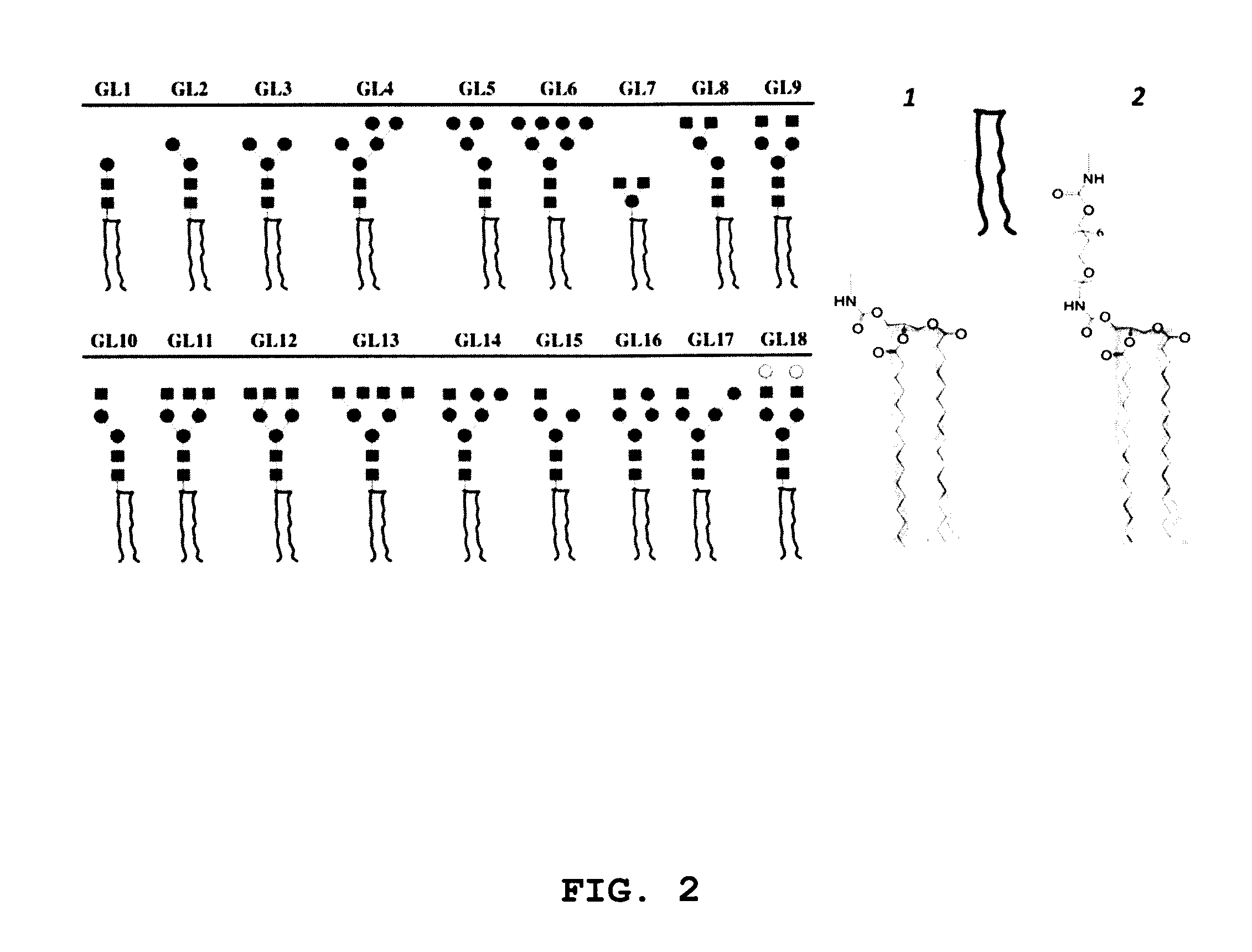Methods for making microarrays and their uses
a microarray and microarray technology, applied in combinational chemistry, instruments, chemical libraries, etc., can solve the problems of limiting the mass spectrometric analysis of microarrays, especially those with small size, and limiting efforts in this direction to commercial well plate formats or slides with manually deposited binding, so as to maximize the utility of valuable biochips, broaden the range of applications, and different sensitivity
- Summary
- Abstract
- Description
- Claims
- Application Information
AI Technical Summary
Benefits of technology
Problems solved by technology
Method used
Image
Examples
experimental examples
[0128]In the following experimental examples, the present invention is exemplified using “bottom up” attachment strategy involving non-covalent binding agent attachment to ITO-covered transparent glass slides to develop micrometer-scale microarrays. In situ attachment of glycans functionalized with a C5-aminolinker to a hydrophobic tag bound to slide surfaces allowed glycans to be attached on a picomolar scale, thus avoiding the wasteful off-chip binding agent tagging of other approaches.
[0129]Microarrays were then used for the multimodal analysis of glycan interactions, structures and modifications by MALDI-Tof-MS, fluorescence and optical microscopy. Specificities of various glycosyltransferases were assayed by incubation with selected lectins and by MALDI-Tof and MS / MS analysis. The examples provide a demonstration of the utility of the microarrays in the development of large glycan libraries by on-chip enzymatic processing. Furthermore, different glycoforms of a protein trapped ...
example 1
Preparation and Characterization of Hydrophobic ITO Slides
Surface Modification of ITO Slides
[0130]ITO covered slides were washed by immersion in basic piranha solution and silanized by shaking in 2% APTES (3-aminopropyl trietoxysilane) solution in CH2Cl2 for 2 h. Slides were then rinsed twice in CH2Cl2 solution, dried, cured at 80° C. for 2 h and purged with Ar. N-succinimidyl (NHS) stearic acid was synthesized by dissolving 600 mg stearic acid in 15 mL CH2Cl2 and mixing with 1.1 equivalents of N-hydroxysuccinimide (NHS) and Ar-(3-dimethylaminopropyl)-N′-ethylcarbodiimide hydrochloride (EDC) for 2 h at room temperature. After silanization, slides were coupled with NHS-activated stearic acid to create a hydrophobic SAM. Slides were treated with 10 mM NHS-stearic acid in DMF with 150 mM DIPEA overnight, washed, dried and purged with Ar. Slides were then stored at room temperature under vacuum until use.
Non-Silanized ITO Slides
[0131]Direct surface modification on non-silanized ITO slid...
example 2
Printing and Characterization of Glycan Arrays
Robotic Printing of Glycans
[0138]Stock solutions of C5-amino linked N-glycans G1 to G18 were prepared at 50 μM in phosphate buffer (300 mM, pH 8.7). Aliquots of ˜15 mL of each glycan (˜0.7 pmol) were applied to slide surfaces with a dot pitch of 750 μm, and slides were incubated overnight at room temperature in a humidity chamber. Slides were subsequently washed by sonication in water and dried in a stream of Ar. FIG. 2 provides schematic representations of glycolipid compounds formed by reaction of C5-amino linked N-glycans G1-G18 with bidentate linker compounds 1 and 2 on surfaces A and B, respectively.
Characterization of the Glycan Array
(i) Using Labelled Lectins
[0139]Arrays were quenched with 50 mM ethanolamine (in 50 mM borate buffer, pH 9.3) for 1 h, and passivated with 2% BSA in PBS for 1 h. Fluorescently-labelled lectins in PBS buffer containing 2 mM CaCl2 and 2 mM MgCl2 were used to detect immobilized glycans.
[0140]For array cha...
PUM
| Property | Measurement | Unit |
|---|---|---|
| diameter | aaaaa | aaaaa |
| molecular weight | aaaaa | aaaaa |
| thick | aaaaa | aaaaa |
Abstract
Description
Claims
Application Information
 Login to View More
Login to View More - R&D
- Intellectual Property
- Life Sciences
- Materials
- Tech Scout
- Unparalleled Data Quality
- Higher Quality Content
- 60% Fewer Hallucinations
Browse by: Latest US Patents, China's latest patents, Technical Efficacy Thesaurus, Application Domain, Technology Topic, Popular Technical Reports.
© 2025 PatSnap. All rights reserved.Legal|Privacy policy|Modern Slavery Act Transparency Statement|Sitemap|About US| Contact US: help@patsnap.com



